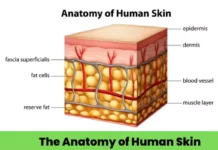Have you ever thought about the incredible role your skin plays in your daily life? This remarkable organ is far more than just a protective covering; it’s a complex system that safeguards your body and reflects your overall health. With its myriad functions, your skin is truly essential. So, what exactly makes it so special? Let’s dive into the fascinating world beneath the surface and explore the secrets of your skin.
In this article, we’ll uncover the structure of human skin, its vital layers, and the multitude of benefits it offers. You’ll discover how your skin functions, why it’s important to care for it, and the incredible ways it contributes to your well-being.
Understanding the Skin: An Overview
Your skin is the largest organ in your body, making up about 16% of your total weight. Covering roughly 2 square meters, it serves as a protective barrier against the outside world. Interestingly, the thickness and texture of your skin vary depending on its location. For example, it’s much thinner around your eyes compared to the thicker skin on your palms and soles. Essentially, your skin has two primary layers: the epidermis, which is the outer layer, and the dermis, which lies beneath it.
Exploring the Layers of Human Skin
The Epidermis: Your Skin’s Shield
The epidermis is the visible outer layer that acts as your skin’s first line of defense. It provides a waterproof barrier and contains melanocytes, the cells responsible for your skin color. Interestingly, skin cells in the epidermis take about 28 days to migrate to the surface, where they eventually shed. This natural exfoliation process, known as desquamation, slows down as you age, making regular exfoliation a crucial aspect of any skincare routine.
The Dermis: The Heart of Skin Health
Just below the epidermis lies the dermis, often referred to as the “true skin.” This layer is a bustling hub filled with blood vessels, lymphatic vessels, and nerve endings. The dermis is essential for skin health, providing sensitivity to touch, pain, and temperature. It also contains collagen and elastin, which give your skin its strength and elasticity, making it vital for overall skin function.
The Subcutaneous Layer: The Body’s Cushion
The subcutaneous layer, or hypodermis, is the innermost layer, primarily made up of fat and connective tissues. This layer serves multiple purposes, including providing cushioning and insulation for your body. It protects your internal organs and helps regulate body temperature. Additionally, this layer stores fat for energy and contributes to the overall structure and plumpness of your skin.
The Multifaceted Benefits of Skin
Your skin does a lot more than just look good. Here are some of its key benefits:
The Intricate Relationship Between Skin and Health
Your skin acts as a mirror, reflecting your internal health. It balances hydration while allowing sweat to evaporate, maintaining your body’s comfort. Moreover, your skin continuously adapts to what you consume, using nutrients to support its own health. It’s fascinating how your skin can tan and produce melanin to protect against harmful UV rays, showcasing its remarkable capabilities.
In essence, your skin is not merely a covering; it’s a complex organ that serves as a protector, healer, and communicator, playing a crucial role in your overall well-being.





















